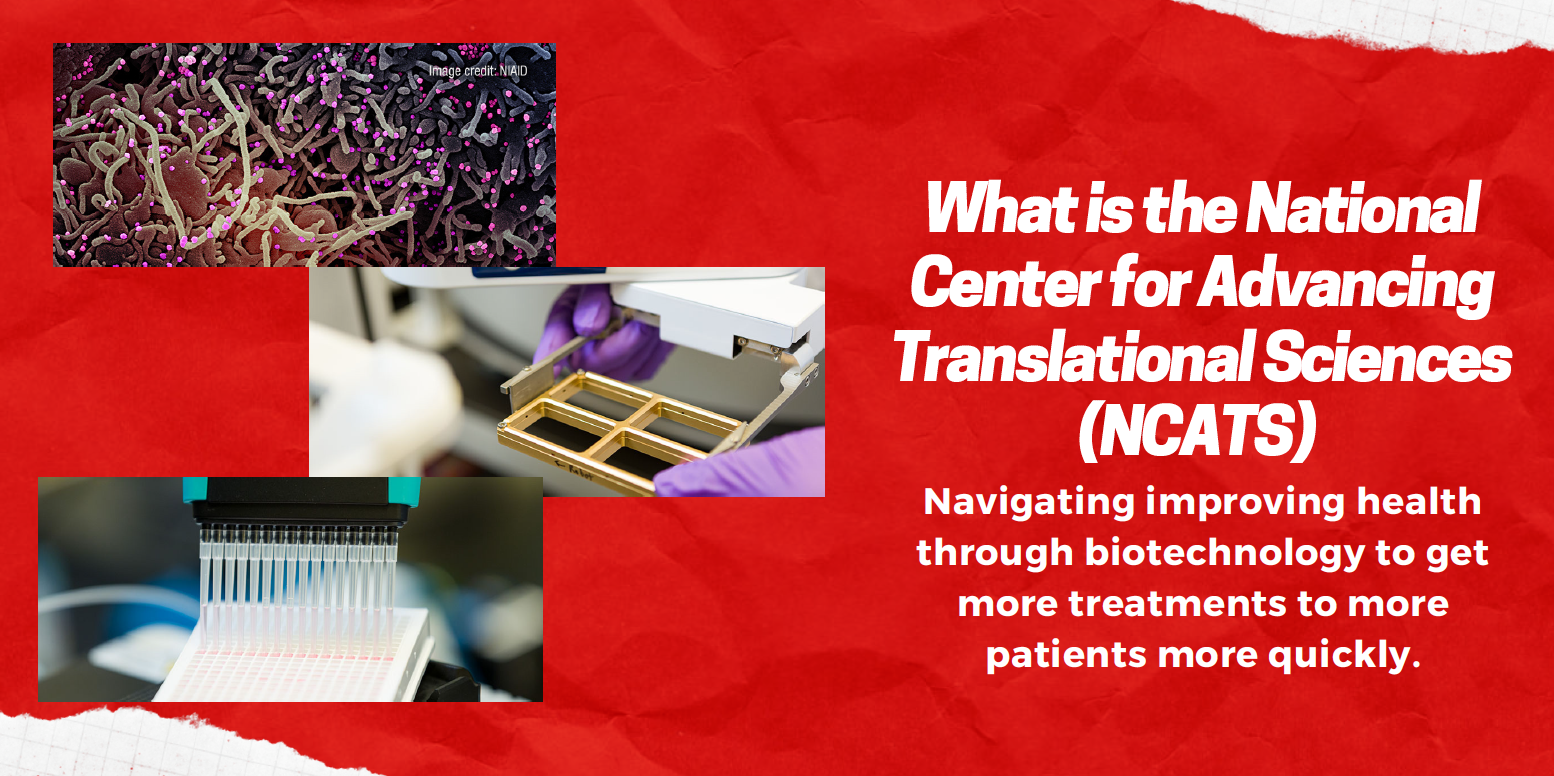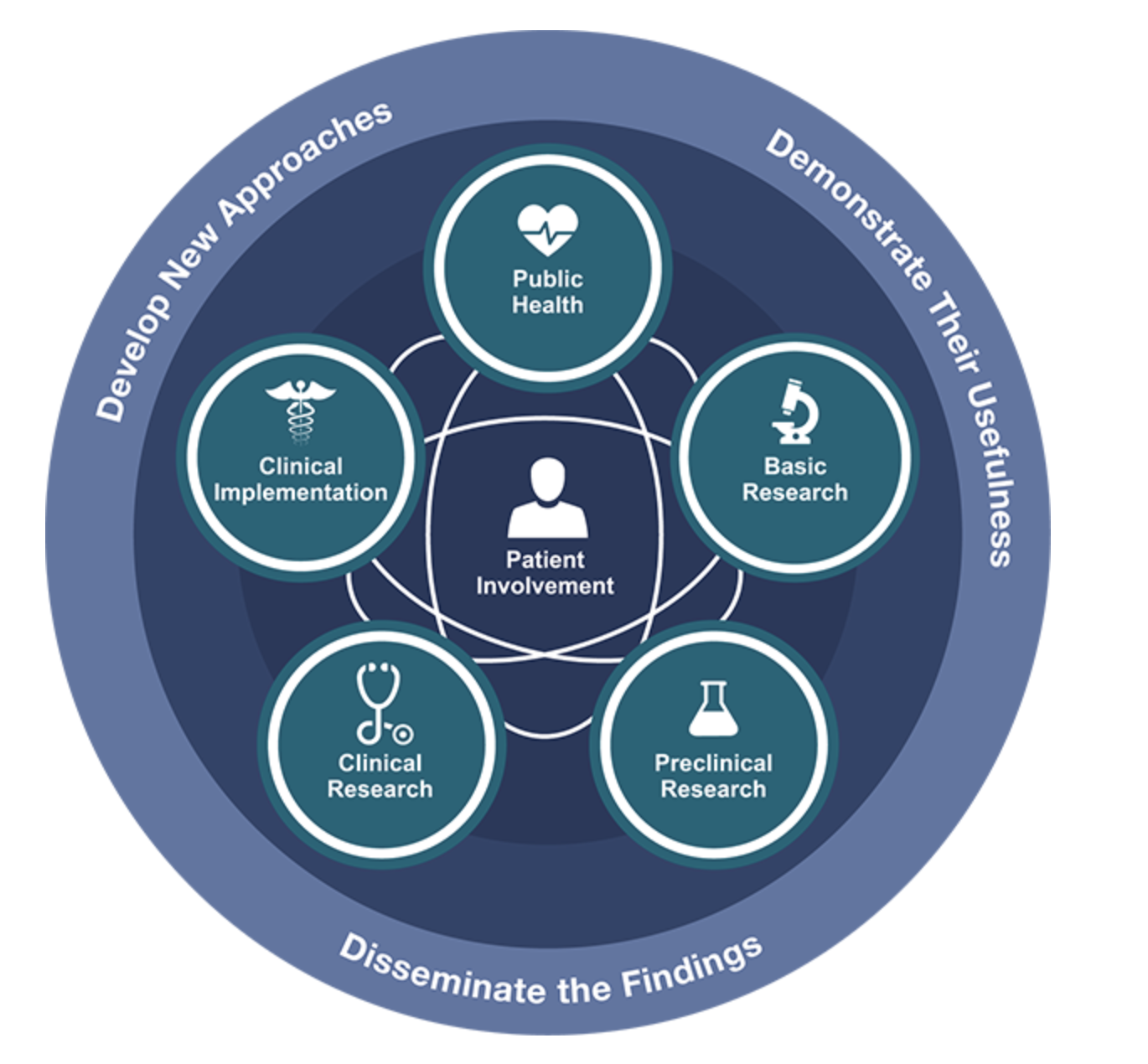
Legend: The National Center for Advancing Translational Sciences uses revolutioned
translational science to bring new treatments and cures for disease directly to patients
by collaborating with other government agencies and patient support organizations.
Background History
The National Center for Advancing Translational Sciences (NCATS), part of the
NIH, was established in 2011 to address a critical gap in bringing biomedical research
advances to patients by establishing a research program and developing a workforce
focused on these larger issues in improving health (Haynes et al., 2020). The stated
mission of National Center for Advancing Translational Sciences is to “catalyze the
generation of innovative methods and technologies that will enhance the development,
testing, and implementation of diagnostics and therapeutics across a wide range of
human diseases and conditions” (National Center for Advancing Translational Sciences,
2021).
What is the National Center for Advancing Translational Sciences?
The National Center for Advancing Translational Sciences is part of the National
Institues of Health focused on the translational science process to bring new treatments
and cures for disease to patients faster. Translation is the process of turning
observations in the laboratory, clinic and community into interventions that improve the
health of individuals and the public — from diagnostics and therapeutics to medical
procedures and behavioral changes (National Center for Advancing Translational
Sciences, 2021). The National Center for Advancing Translational Sciences uses
translation sciences by not focusing on specific disease, but on what is common among
them and emphasizes innovation and deliverables.
The National Center for Advancing Translational Sciences approach revolves
arond three goals, as they call them the “3Ds:
- Developing new approaches, technologies, resources and models
- Demonstrating their usefulness
- Disseminating the data, analysis and methodologies to the community
(National Center for Advancing Translational Sciences, 2021).
Why was the National Center for Advancing Translational Sciences established?
The National Center for Advancing Translational Sciences was established to
deliver treatments and cures for diseases to patients faster because there were many
gaps in developing new drug interventions. There are several thousand genetic
diseases affecting humans, but only about 500 of these diseases have any kind of
treatment. Current methods of developing a new intervention take too long, are too
costly, and the vast majority of new therapies – about 95 percent – never make it past
clinical trials. The average time from discovery of a therapeutic target to approval of a
new drug currently is about 14 years, and the cost per successful drug can be more
than $1 billion (National Center for Advancing Translational Sciences (NCATS), 2021).
When a new drug or treatment is developed and shown to be effective in clinical
trials, many years may pass before all patients who could benefit from it are identified
and treated (National Center for Advancing Translational Sciences (NCATS), 2021).
This is due to many different roadblocks that prevent the full potential of the drug being
discovered. Obstacles that stand in the way include:
- Lack of understanding about the science of translation
- A shortage of qualified investigators
- Organizational structures and incentives that do not encourage the teamwork
essential to translational science - Inflexible, inefficient clinical trial designs and low participation in studies
(National Center for Advancing Translational Sciences (NCATS), 2021)
The National Center for Advancing Translational Sciences bridges these gaps by
using the translational science spectrum which represents each stage of research along
the path from the biological basis of health and disease to interventions that improve the
health of individuals and the public (National Center for Advancing Translational
Sciences, 2021). At all stages of the spectrum, The National Center for Advancing
Translational Sciences develops new approaches, demonstrates their usefulness and
disseminates the findings. Patient involvement is a critical feature of all stages in
translation (National Center for Advancing Translational Sciences, 2021).

Legend: The translational science spectrum represents each stage of research and the
spectrum is not linear or unidirectional; each stage builds upon and informs the others
(National Center for Advancing Translational Sciences, 2021).
The National Center for Advancing Translational Sciences
Programs and Initiatives
There are many innovative projects being done by NCATS-supported programs
and initiatives. These projects evolve around using different techniques and assays for
further development and advancing drug development for clinical testing and collecting
data to develop drugs for diseases.
Some projects and initiatives that stand out are:
- 3-D Tissue Bioprinting Program
- NCATS experts are applying techniques of 3-D printing to develop
tissue models that mimic the structure and organization of cells in
the tissues of living organisms
- NCATS experts are applying techniques of 3-D printing to develop
- Bridging Interventional Development Gaps (BrIDGs)
- The BrIDGs program assists researchers in advancing promising
therapeutic agents through late-stage preclinical development
toward an Investigational New Drug application and clinical testing.
- The BrIDGs program assists researchers in advancing promising
- Discovering New Therapeutic Uses for Existing Molecules (New
Therapeutic Uses)- Improves the process of developing new treatments and cures for
disease by finding new uses for assests that are already developed
- Improves the process of developing new treatments and cures for
- Theraputics for Rare and Neglected Diseases (TRND)
- The TRND program supports preclinical development of therapeutic
candidates intended to treat rare or neglected disorders, with the
goal of enabling an Investigational New Drug application.
- The TRND program supports preclinical development of therapeutic
These projects and all of the others can be found on The National Center for
Advancing Translational Sciences website (National Center for Advancing Translational
Sciences, 2021).
Implementation
An example of how NCATS-supported research is being implemented is a new
automated machine-learning approach for diagnosing seriously ill children with genetic
diseases, particularly infants in intensive care units more quickly by combining rapid
whole-genome sequencing with automated phenotyping and interpretation (National
Center for Advancing Translational Sciences, 2021). This approach helps achieve a
diagnosis by comparing a patient’s genomic results with clinical information from
electronic health records, reducing the need for labor-intensive manual analysis of
genomic data. Automating this step significantly decreases the time of diagnosis and,
consequently, the time to initiate appropriate treatment (National Center for Advancing
Translational Sciences, 2021).
References
1) Haynes, B., Brimacombe, K., Hare, C., & Faupel-Badger, J. (2020). The National
Center for Advancing Translational Sciences’ Intramural Training Program and
Fellow Career Outcomes. CBE—Life Sciences Education, 19(4), ar51.
https://doi.org/10.1187/cbe.20-03-0048
2) National Center for Advancing Translational Sciences (NCATS). (2021). Federal
Laboratory Consortium for Technology Transfer .
https://federallabs.org/labs/national-center-for-advancing-translational-sciences-n
cats
3) National Center for Advancing Translational Sciences. (2021).
https://ncats.nih.gov/index.php